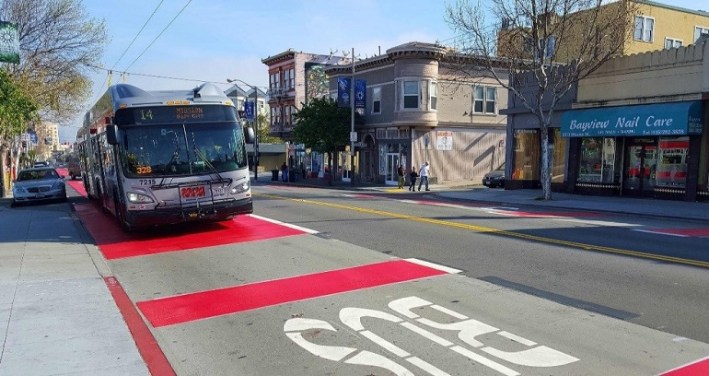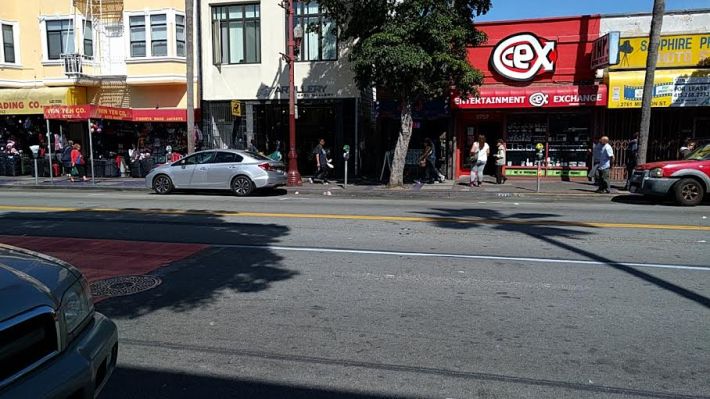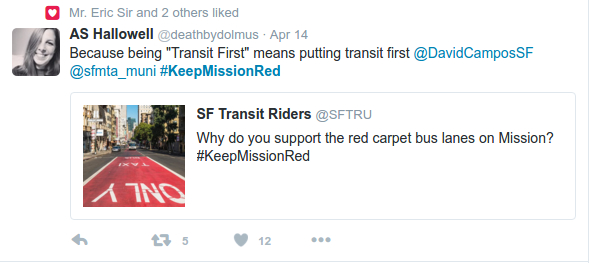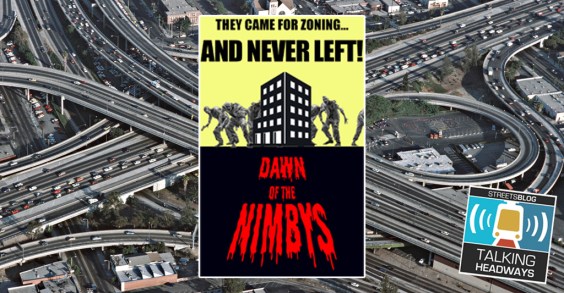
Businesses in the Mission are complaining to Supervisor David Campos about the new "Red Carpet" painted transit lanes. And there's already talk about taking them out. The San Francisco Transit Riders Union (SFTRU) reacted in an email blast last week:
Starting in March, after a decade of numerous community discussions, planning and studies, Muni finally started installing transit priority treatments on Mission Street. Just a month in and despite flagrant violations by drivers, they are already benefiting riders by making their rides faster and more reliable.
However, there has been a major backlash against these changes, and some, in particular Supervisor Campos, have called for rollback of this major progress. It is a betrayal of the 65,000 riders who are served by the 14, 14R and 49 buses, as well as a betrayal of the Transit First charter of this city.
This is what Campos had to say about the lanes on his Facebook page:
While I understand the intention was to enhance the commute of 65,000 transit riders, the changes look better on paper than in practice. I have heard from many of you--car commuters frustrated by traffic jams that stretch multiple blocks...That’s why I’m calling on the San Francisco Municipal Transportation Agency to make a radical shift in the program. We look forward to announcing a solution shortly. In the meanwhile, please email your concerns to the SFMTA at matthew.brill@sfmta.com.
The SFTRU is pretty peeved that Campos is even suggesting undoing the results of all their hard work. They've set up a web page, letting transit-supporters know how to stop this roll back. As the SFTRU put its outrage:
The paint has hardly dried. Yet the transit only lanes on Mission Street may go away soon. If prioritizing transit is not possible on Mission Street, one of Muni’s key corridors, then will we ever see Muni become world-class system in our lifetimes?
But let's back up a second. Do the business owners who say the transit lanes make it harder to drive to their shops and are keeping away customers, really have a basis to complain?
Studies show that businesses tend to get it wrong about how many customers arrive by car. Regardless, figuring how it impacts bottom lines on Mission would be difficult. A sampling of businesses would have to offer their books for an audit. And then if sales receipts really went down from this time last year, it would have to be compared to businesses a few blocks away, to make sure it's not a reflection of the regional economy. Nonetheless, the businesses that Streetsblog talked with seemed convinced the lane is a net negative.
"Oh yeah, we're down 30 to 35 percent," said Emin Ali, owner of the Mi Pueblito Market near the 24th Street BART station. Adding he "wants it back like before." Juan Antimo, the owner of JJ's Hair Salon, a few stores to the north, was also convinced the bus lane is damaging to business. "My clients complain about it," he said, pausing from clipping a man's hair.
Another couple of doors down, at Artillery Apparel Gallery, manager Alexa Trevino was eager to talk about the lanes. "Horrible! Bad for business!" she said. "Can't get anything from delivery." When asked why delivery vehicles don't park farther away and use a dolly, she said that dollies can damage the product.

Perhaps one has to run a small business to fully appreciate the reasons for the complaints (Streetsblog would like to read comments from small-business owners), but it does seem like a windshield perspective: that everyone is entitled to an always-available parking spot right in front of their home and shop. That said, Trevino bikes to work and she also complained about the lack of bike lanes. "It's not safe," she said, opining that the bus lanes made it even worse for cycling. "I'm afraid I'll get hit by a bus."
Streetsblog is on the record for not approving of how this lane was set up, principally because of how cyclists were basically given nowhere to ride. The confusion that motorists experience about where to turn and where to go straight, might also be less acute if the transit-only lanes were in the center with boarding islands. Part of the driver confusion no doubt stems from flipping the transit-only lane back and forth from right to center, depending on the stretch of Mission, to allow cars to make right turns. If the cars were driving to the right of the transit lane all the time, as they do on stretches of Market and elsewhere, it might be less of a mess at intersections. That said, the markings could be much clearer, as the SFTRU pointed out in an email to Streetsblog.
Why are turn signs at Mission & 24th invisible? Why no ped priority walk signal?
Either way, no matter what SFMTA does, motorists will get grumpy when they lose lanes--that's why going in with all the incremental half-measures and compromises seems so futile. Compromise results in blowback. Doing it right the first time results in blowback. Let's save the compromises for later.
The SFTRU, meanwhile, has set up the hashtag #KeepMissionRed Tweets to get pro-transit people talking. Its followers wasted no time countering the complaints, with plenty of tweets along these lines:
Streetsblog readers, especially if they live in the district, need to email Campos's office, hit Facebook and Twitter, and just join the conversation. Because, as "AS Hallowell" put it, yes, "transit first" is supposed to mean transit first.

As to the businesses on Mission and whether they are truly harmed, Antimo, the barber, said his clients are frustrated by the lack of parking. "They will think twice about coming next time," he added, before continuing to cut his customer's hair. However, when the customer was asked how he got to the shop, he shrugged and said "I took the bus."






